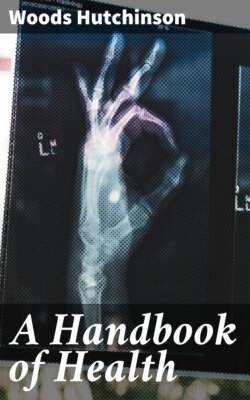Читать книгу A Handbook of Health - Woods Hutchinson - Страница 19
На сайте Литреса книга снята с продажи.
PROTEINS, OR "MEATS"
ОглавлениеProteins, the "First Foods." There are proteins, or "meats," both animal and vegetable; and no one can support life without protein in some form. This is because proteins alone contain sufficient amounts of the great element called nitrogen, which forms a large part of every portion of our bodies. This is why they are called proteins, meaning "first foods," or most necessary foods. Whatever we may live on in later life, we all began on a diet of liquid meat (milk), and could have survived and grown up on nothing else.
Composition of Proteins. Nearly all our meats are the muscle of different sorts of animals, made of a soft, reddish, animal pulp called myosin; the other principal proteins being white of egg, curd of milk, and a gummy, whitish-gray substance called gluten, found in wheat flour. This gluten is the stuff that makes the paste and dough of wheat flour sticky, so that you can paste things together with it; while that made from corn meal or oatmeal will fall to pieces when you take it up. The jelly-like or pulp-like myosin in meat is held together by strings or threads of tough, fibrous stuff; and the more there is of this fibrous material in a particular piece or "cut," of meat, the tougher and less juicy it is. The thick, soft muscles, which lie close under the backbone in the small of the back, in all animals, have less of this tough and indigestible fibrous stuff in them, and cuts across them give us the well-known porter-house, sirloin, or tenderloin steaks, and the best and tenderest mutton and pork chops.
Fuel Value of Meats. Weight for weight, most of the butcher's meats—beef, pork, mutton, and veal—have about the same food value, differing chiefly in the amount of fat that is mixed in with their fibres, and in certain flavoring substances, which give them, when roasted, or broiled, their special flavors. The different flavors are not of any practical importance, except in the case of mutton, which some people dislike and therefore can take only occasionally, and in small amounts.
The amount of fat in meats, however, is more important; and depends largely upon how well the animal has been fed. There is usually the least amount of fat in mutton, more in beef, and by far the greatest amount in pork. This fat adds to the fuel value of meat, but makes it a little slower of digestion; and its presence in large amounts in pork, together with the fact that it lies, not only in layers and streaks, but also mixed in between the fibres of the lean as well has caused this meat to be regarded as richer and more difficult of digestion than either beef or mutton. This, however is not quite fair to the pork, because smaller amounts of it will satisfy the appetite and furnish the body with sufficient fuel and nutrition. If it be eaten in moderate amounts and thoroughly chewed, it is a wholesome and valuable food.
Veal is slightly less digestible than beef or mutton, on account of the amount of slippery gelatin in and among its fibres; but if well cooked and well chewed, it is wholesome.
The other meats—chicken, duck, and other poultry, game, etc.—are of much less nutritive value than either beef, pork, or mutton, partly because of the large amount of waste in them, in the form of bones, skin, and tendons, and partly from the greater amount of water in them. But their flavors make them an agreeable change from the staple meats.
Fish belongs in the same class as poultry and consists of the same muscle substance, but, as you can readily see by the way that it shrinks when dried, contains far more water and has less fuel value. Some of the richer and more solid fishes, like salmon, halibut, and mackerel, contain, in addition to their protein, considerable amounts of fat and, when dried or cured, give a rather high fuel value at moderate cost. But the peculiar flavor of fish, its large percentage of water, and the special make-up of its protein, give it a very low food value, and render it, on the whole, undesirable as a permanent staple food. Races and classes who live on it as their chief meat-food are not so vigorous or so healthy as those who eat also the flesh of animals. As a rule, it is not best to use fish as the main dish of a meal oftener than two or three times a week.
